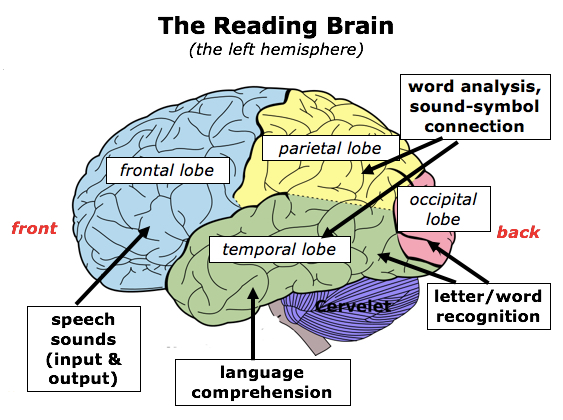What Happens Inside Your Child’s Brain When They Read?
By Madhurie Singh, June 20, 2025



Join Trusted Parents Group to connect with Madhurie Singh
What This Brain Diagram Means for Your Child’s Reading
This image shows the left side of your child’s brain, which is mostly responsible for reading, understanding, and using language.
Even though reading looks simple from the outside, it actually activates many different parts of the brain at once. And each part has a job to do.
Let’s break it down:
🔵 Frontal Lobe – Speech Sounds + Thinking
- This is where your child’s brain works on saying the sounds out loud and planning what they’re reading.
- It’s also where they think about meaning — like asking, “What is this sentence trying to say?”
- It’s active when kids read aloud, sound out words, or discuss stories.
🟢 Temporal Lobe – Understanding Words
- This part helps with language comprehension — making sense of the words being read.
- It’s like the “translator” that helps connect written words to what your child already knows.
- When your child hears or reads the word “star,” this part remembers what a star is.
🟡 Parietal Lobe – Linking Sounds and Letters
- Here, the brain connects how a word sounds to how it’s spelled.
- It’s important for spelling, reading new words, and breaking down tough words like “elephant” into “el-e-phant.”
- It also helps your child know the difference between similar-looking or sounding words.
🟠 Occipital Lobe – Seeing and Recognizing Letters
- This part helps with recognising letters and words on the page.
- It sends the visual information (what the eye sees) to the rest of the brain for understanding.
- Without this, a child might mix up letters or have trouble tracking lines while reading.
💡 Why This Matters
When your child reads with their own eyes, voice, and brain, all these parts are active and learning to work together.
But when AI reads aloud, summarizes, or solves questions, many of these areas don’t light up. The brain receives — but doesn’t process. Over time, the brain doesn’t build the strength it needs for deep comprehension, creative thinking, or strong memory.
📌 Conclusion
“Reading is not just about finishing a chapter — it’s about making the brain stronger with every line. If we don’t let our kids use these areas often, it’s like having a gym machine at home and never using it.”
✍️ About the Author Madhurie Singh is a parenting and education expert, known for her powerful, practical insights on raising resilient children in modern India. With over 20 years of experience working with parents, students, and schools, she is passionate about blending ancient wisdom with modern science. Learn more at madhuriesingh.com.
📌 Want to Raise AI-Ready but Brain-Strong Kids? Join our parenting community on WhatsApp where Madhurie shares weekly tips, tools, and activities to balance AI use and brain development. 👉 If you wish to connect with me for school consultation or parenting or career advices, do write to [email protected] or WhatsApp 9890036569. Join the Trusted Parents Group.
Do read my best article on AI where I am telling you how our children’s brains are in the danger of getting destroyed, AI and Indian Kids: Is It Helping or Hurting Brain Development?
And this article is important to know how our brains works when we read a book which AI will prevent , What Happens Inside Your Child’s Brain When They Read?
Reference Sources:
How Effective is Critical Reading in the Understanding of Scientific Texts? Researchgate.net
Brain activation for reading and listening comprehension National Library Of Medicine, USA
How Memories Are Made: Stages of Memory Formation Lesley University, USA
AI Image Generator: Online Text to Image App, Canva
Psychologically speaking: your brain on writing, University of Waterloo
Improving emotion regulation and communication for children , ScienceDirect.com
Where in the brain does creativity come from? JWU.edu
The brain makes sense of math and language in different ways , University of Maryland
Brain Anatomy and How the Brain Works, John hopkins Medicine, USA
10 Smart Ways to Prevent Kids from Becoming Addicted to AI Tools






Login is required
Don't have an account? Sign Up